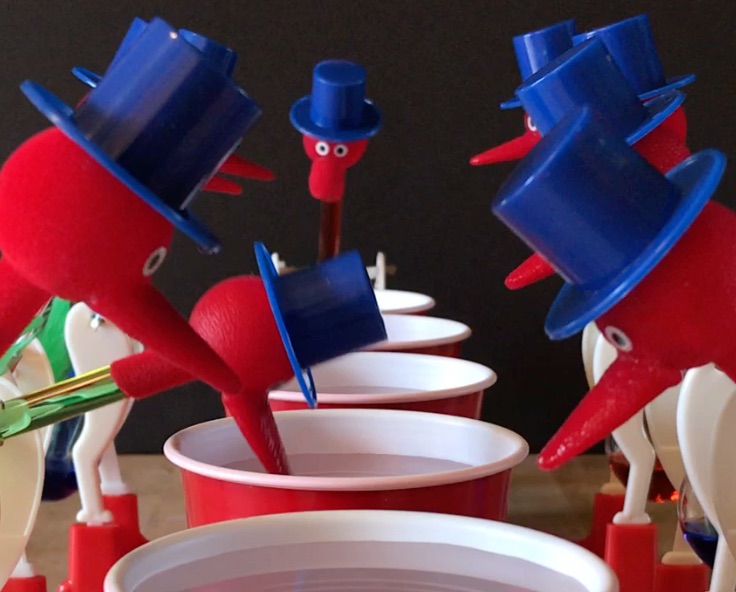The Gravity Light
Description: The Gravity Light converts potential energy that is stored in a weight into light. The principles involved in this design are very similar to the principles in a cuckoo clock, with the potential energy of the weight being converted to solar energy rather than kinetic energy. Gravity Lights can replace kerosene lights in the developing world with a safe alternative. The phenomenon can be used to illustrate the conversion of potential gravitational energy into other forms of energy. More importantly it conveys the message of sustainability and social responsibility.
Web Resource: The Gravity Light - Wikipedia, The Gravity Light Foundation
Amazing Rube Goldberg Machines
Description: Rube Goldberg machines are named after American cartoonist Rube Goldberg who drew complicated steps involved in doing a fairly simple task (like pouring milk in a glass). Students can study these machines, or build their own, to show how energy can be converted through a series of interactions. In lower elementary classes they might be shown or built to show how pushes or pulls can change the motion of objects. As they move through school they should start to identify specific collisions, interactions, and conversions of energy.
Web Resources: Rube Goldberg Machines - Wikipedia
Candle-Powered Car
Description: The candle-powered car is an application of the Seebeck Effect. This effect is the result of thermal energy conversion directly into electricity. This phenomenon can be used in elementary school to show energy conversion from heat to electricity to the kinetic energy of the car. A more detailed explanation will be required in high school related to electron response to temperature differences in different materials. The Seeback circuit used in this candle-powered car can also be connected to a voltmeter and used as a temperature sensing thermocouple.
Web Resource: Seebeck Effect, Candle Car Kit - Amazon
Solar Cars
Description: Solar cars use energy from the sun and photovoltaic cells to transport humans. Large solar cars are generally built by universities to compete in solar car races but mini-solar cars can be built in any science classroom. The photovoltaic cells convert solar energy into electricity which runs an electric motor. Energy conversion can be studies within the unit and a solar car design challenge can be used as a culminating design challenge. The criteria and constraints can be modified to the age of the students in the class.
Web Resource: Solar Car - Wikipedia
Amazing Slinky Tricks
Description: The Slinky was invented by Richard James, an engineer, who was working with springs to support and stabilize equipment on a ship. Simple slinky tricks show how forces (pushes and pulls) change the direction of an object. Students can design a set of stairs, or obstacles, that the Slinky can navigate. In the secondary science classroom it can be used to investigate inertia, oscillations, and Hooke's law. This phenomenon can also be used to investigate wave properties.
Web Resource: Slinky - Wikipedia
Earthships
Description: An Earthship is a passive solar house that is designed to be off the electrical grid. It is generally constructed with natural and recycled materials. Much of the structure of the house is made with recycled tires that are filled with dirt. Thermal mass from the dirt, solar energy from the Sun, and cross-ventilation are used to keep the temperature within the house in a comfortable zone. This phenomenon can be used study thermal energy transfer, energy conservation, and human sustainability.
Web Resource: Earthship - Wikipedia
Magnetic Cannon
Description: The magnetic cannon contains four spaced neodymium magnets in a channel. Two balls bearings are placed between each ball bearing. When a new ball bearing is introduced a transfer of energy occurs and the final ball bearing leaves with a higher initial velocity than the first. This is a great phenomenon for studying transfer of momentum and the energy of an object based on its position within a magnetic field.
Web Resource: Magnetic Challenge with Bozeman Science
The Drinking Bird
Description: The drinking bird is a toy heat engine. The source of energy in this phenomenon is a mystery to most students. It is said that Albert Einstein and his wife Elsa were fascinated with this toy when they visited Shanghai in the 1920's.
Web Resources: The Engineering of the Drinking Bird, The Drinking Bird - Wikipedia











